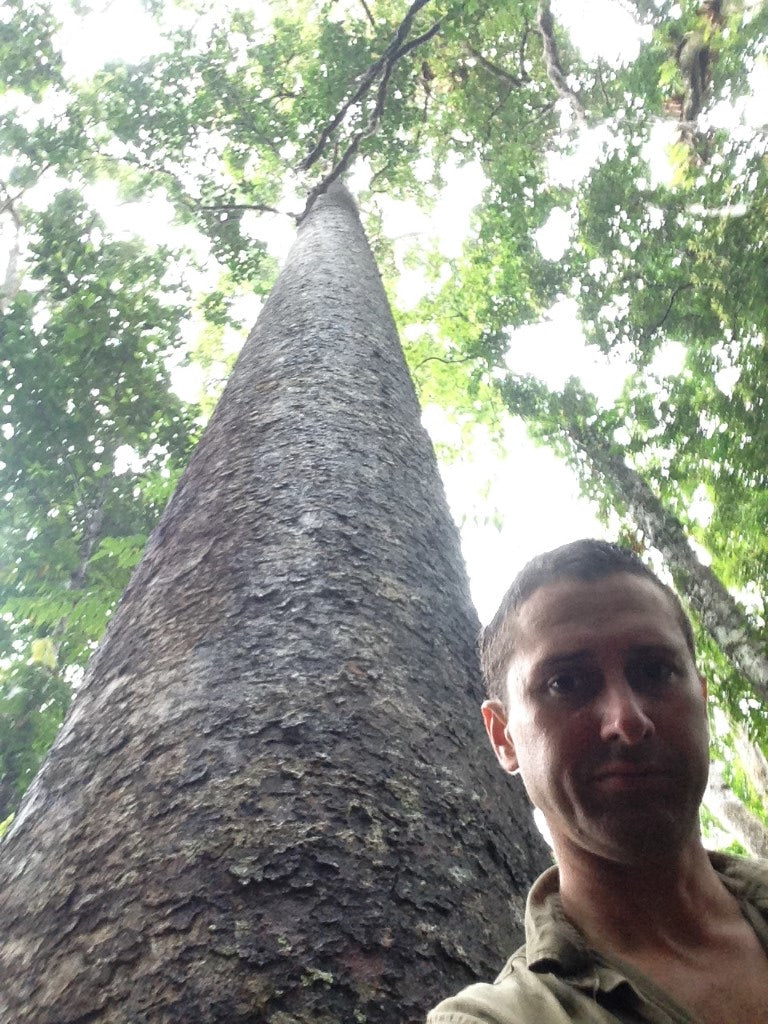By Reuben Wertz
The possibility that there may yet be an undescribed species of Agathis in PNG came to light earlier this year while discussing tropical conifers over a coffee with Geoff Stocker at his home on the Atherton Tableland in North Queensland, Australia. Geoff is a specialist in tropical forestry and spent several years in PNG as the Professor of Forestry at the PNG University of Technology and as Director of the PNG Forest Research Institute. He mentioned that towards the end of his contract with the Institute (February 1996), he was asked by officers of the Forestry Department to investigate reports from local staff that an Agathis species was being logged on the island of Lavongai (New Hanover) in the far north west of New Ireland Province.

The Department had no previous records of Agathis from this island and its presence was somewhat unexpected. Administratively the report was of significance since the export of all conifers (and several other high value species such as Ebony) in round log form was banned country wide and the Asian logging company’s licence was only valid for log exports.
At the time of Geoff’s visit to check the reports from Lavongai, two Agathis species had been recorded for Papua New Guinea. A. labillardieri had been found in small scattered stands in the west of PNG and also in neighbouring West Papua. A. spathulata (previously A. robusta ssp nesophila) occurs in small stands through the eastern part of the mainland and also on the island of New Britain.
Geoff provided me with the following account of his visit to Lavongai;
Geoff chose a senior program leader at the Institute, Tom Kosi to accompany him on what was to be a flying visit. They flew from Lae to Kavieng on the northern tip of New Ireland.

Here Forestry Department employees with an outboard-powered aluminium dingy met them. The following morning they set off through a maze of reefs and islets to the forestry camp on the north coast of Lavongai. Next day Geoff travelled with some forestry employees in a 4 wheel drive along a logging road which ended midway up the mountain range. Overnight Tom had met some of the local villagers and decided to access the mountain via traditional tracks from the other side. They arranged to meet near the summit later that day. From the end of the road Geoff followed snigging tracks and soon located a stand with scattered trees of Agathis. Tom’s journey was far more arduous and he didn’t join up with Geoff until mid-afternoon.
Geoff concentrated on trying to determine the approximate extent of the stand and thought it was probably confined to a relatively small area a hundred metres or so below the summit. Most Agathis trees in the stand appeared to have escaped logging. Unfortunately Geoff was unable to collect decent botanical material to accurately determine the species. A few fragments including a wood sample were lodged in the Lae Herbarium. Geoff recalls that the wood sample (cut from the stump of a felled tree) was very light in weight. Tom and Geoff returned to Kavieng the next day.
I contemplated Geoff’s account for a few days, referring to maps and satellite photos trying to pinpoint the place he encountered the Agathis. Over a few more conversations I picked his memory for every last detail. My research had revealed a paper by T.C. Whitmore published 1980 (The New Phytologist) which declared Agathis absent from nearby New Ireland mainland, so Geoff's discovery grew even more intriguing. The geographic isolation from other occurrences suggested a strong possibility it would be distinct from known species. By August 2019 I had acquired enough information to mount a search. The island is only 260 km from a mining operation where I spend a few months each year. Some of my national crew were familiar with the area or had wantok (relatives) who could help me out, so while on break I flew to Kavieng to start my journey.
Clem Anton and John Sumaien met me at the hotel and we formulated a plan for travel to the island. Based on Geoff's recollections it appeared the easiest way to access the mountain range was from a coastal village on the remote western side. Next morning we bought fuel and provisions, hired a boat and embarked. Some hours across the water we arrived at a village named Baungnung. It was there we found Peter Vani, a knowledgable local elder and ex-millitary man who immediately recognised what we were after from my collection of photos and botanical sketches. Moments later a boy brought over a branchlet which was clearly Agathis. He led me to a small specimen growing in a garden nearby and described how it began life as a seedling under the big “Munem” tree on the mountain until his wantok transplanted it here some time ago.

A subsequent tour of the village gardens revealed larger planted specimens with DBH 25-30cm and their crowns breaking through the canopy of the coconut plantation. Peter explained that these now sapling trees grew from seedlings collected over 20 years ago by villagers who were with Geoff Stocker the day he stopped the logging operation. Geoff had expressed the importance of these trees so a number of locals took it upon themselves to transplant seedlings for perpetual preservation. He certainly made an impression here and was well regarded by those who remember. I was showed some more garden conifers which originated from local forest. One was likely to be Retrophyllum filicifolium and the other was a species of Podocarpus, with a close similarity in appearance to grayae which has a wide distribution over North Queensland as well as a Western Arnhem Land occurrence. From the coastal village we proceeded up river by boat as far as was navigable then humped swag up hills to a village with a lovely view where the local Pastor was kind enough to accommodate our party for the night.
On 30th August when the rain eased we set out for the mountain. It was disappointing to see all the forest on the foothills destroyed. Three years ago an Asian logging company clear-felled the area under the auspices of a Special Agriculture Business Lease (SABL), a loophole utilised by logging companies to avoid adhering to the sustainable forestry practices required under the government-issued logging permit system. The SABL allows forest lands to be clear-felled for agricultural development and has systemically failed to protect communities’ interests and indigenous land rights. In this case, after exporting every last tree the logging company planted seedlings for a rubber plantation then abandoned the area. Without management the plantings quickly disappeared under bracken fern and raspberry bramble leaving the locals with nothing to show for the loss of their forest, plus the additional burden of now having to walk kilometres to source bush material for their thatch homes.
Near the end of the logging road we turned off the ridge and followed a footpath down to a valley of undisturbed closed-canopy rainforest. After crossing a flooded creek the path followed a steep and narrow mountain spur. The heavens opened up again and the muddy track became a slippery boggy mess. It was prudent to first secure a hand-hold before taking the next step. Climbing ever upwards we passed under some massive Dipterocarps and other giants of which I could only guess the genus. As we gained altitude the gradient eased and the mountain engulfed in cloud. The first Agathis was spectacular, around 1.5m DBH with straight bole and wide spreading crown. Here I was able to find some freshly fallen branchlets (courtesy of marauding parrots) with leaves and pollen cones attached. Searching within the dripline turned up a solitary female cone and plenty of scattered scales indicating seeds were already in dispersal. The forest floor was thoroughly combed for seedlings with about twenty recovered by locals for transplanting in their gardens (everybody wanted one now!)
We continued up the mountain passing one smaller Agathis and in another 10 minutes the anticipated giant loomed grey through the mist ahead. Towering over the track was the largest “Munem” tree. Generations of ancestors must have revered this behemoth on the well-trodden footpad between villages as it bore not a single scar from an indifferent bush-knife. I had packed a rope to measure the circumference but it fell short. An enterprising young man sourced a length of cane from a Calamus palm which proved sufficient to calculate the DBH to approximately 2.2m. There were no cones or seedlings found under this tree which did not surprise the locals at all. This was the “Father” tree they told me - the “Mother” was the first one we passed. However I soon found scales from last year’s cones in the leaf litter and delivered an impromptu lecture on Agathis reproduction to a fascinated audience. After taking the necessary photographs as per instructions from Geoff, and with everyone now wet and cold from ceaseless rain, it was time to make our way down the mountain. We arrived back in the village late afternoon.
There was much discussion that evening. The locals were pleased that somebody was finally taking an interest in their big tree and wanted to know the implications if their “Munem” turned out to be an undescribed species as suspected. What will it be named? To the best of my knowledge I explained the necessity of collecting a type specimen and getting it intact to a taxonomist, a person with the appropriate expertise who could give their tree a description in botanical terms and introduce it to the world.
“What would you like it to be called?”
There was a brief discussion in language which Peter Vani summarised for me afterwards. They concluded the species name should recognise that the Lavongai Agathis bears a name in local dialect which has already been in use for many generations.
“Munem” he said. “Call it Agathis munem.”
The rain wouldn't stop so next morning I reluctantly left the village to continue my circumnavigation of Lavongai and eventually return to Kavieng. The three large Agathis I encountered were clearly not part of the same stand that Geoff had described to me which we had concluded were in the proximity of 400m elevation. My sighting was on a steep ridge at around 200m above sea level on the western slope of the mountain range where the forest remained undisturbed. We did not continue higher to link with the logging road that Geoff had traversed from the north coast. I was able to determine from aerial photos that we were at least two km distant from his 1996 sighting. It was comforting to know that the species is likely dispersed over a much larger area than was suspected at the time of Geoff’s expedition.
After examining my photos Geoff suggested that this Agathis sp. was almost certainly not A. labillardieri as the male cones of this species are generally no longer than 2 - 3cm. whereas the fresh ones found on the forest floor suggest a male cone length of 5 - 6 cm. For the species encountered on Lavongai, A. spathulata is a possibility as well as an A. robusta ssp. however it is impossible to tell whether we have a new species without access to a range of herbarium material which we will endeavour to obtain in the near future.

